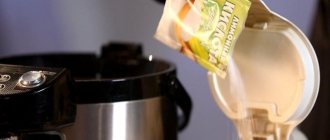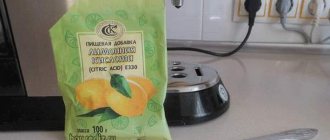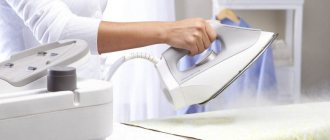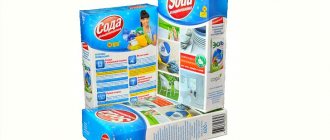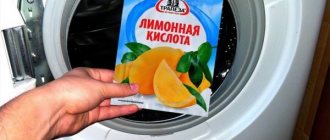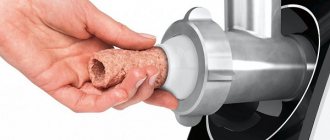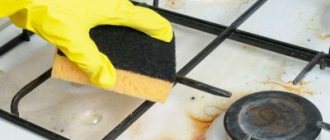When water boils, solid deposits appear inside the kettle, small particles of which even pass through the mesh and end up in the drink. And the view inside the kettle becomes unaesthetic. It will take very little time to get rid of this problem. In addition, every housewife probably has a life-saving remedy in her kitchen.
Find out how to clean a kettle even from old scale using ordinary table vinegar and enjoy a wonderful tea party!
Causes of scale and its harm
The cause of deposits on the walls of the kettle are the salts contained in the water. The most unpleasant for dishes are calcium compounds. When water is heated, calcium carbonates (CaCO3) and magnesium carbonates (MgCO3) are formed. They settle to the bottom, walls and heating elements of the kettle in the form of a rough yellow-gray coating, which is called scale.
The intensity of the appearance of deposits depends on the “hardness” of the water (the level of mineral salts in it) - the higher it is, the faster plaque forms.
Note! Scale not only spoils the appearance of the dishes, but also reduces heat transfer - it takes more time to bring water to a boil. If the inside of the kettle is “dressed in a fur coat” with a thickness of only 1 mm, heat costs will increase by 10%!
The damage caused by scale in electric kettles is especially noticeable. By settling on heating elements, deposits contribute to their rapid failure. As a result, expensive equipment breaks down without using up its full service life.
If you ignore the appearance of scale in the kettle and continue to boil water in it, soon tea drinking will cease to bring joy and pleasure. And all because, along with the water, gray flakes - particles of salt deposits - will begin to fall into the tea cup. This “additive” can ruin not only the appearance of the drink, but also its taste.
Today, there are many ways to completely purify drinking water. But it is the content of microelements in it that makes water “alive”, since they are necessary for the normal functioning of various organs and systems of the body.
There is only one way to preserve the beneficial properties of water and solve the problem of scale - timely cleaning of dishes.
How to descale a kettle with vinegar at home
Do you know that:
The easiest way to remove scale and carbon deposits from the soleplate of the iron is with table salt. Pour a thick layer of salt onto the paper, heat the iron to maximum and run the iron over the salt bed several times, applying light pressure.
Threads made of gold and silver, which were used to embroider clothes in the old days, are called gimp. To obtain them, the metal wire was pulled for a long time with pliers to the required fineness. This is where the expression “to drag out the rigmarole” came from - “to do long, monotonous work” or “to delay the completion of a task.”
The habit of using an automatic washing machine “sparingly” can lead to the appearance of an unpleasant odor in it. Washing at temperatures below 60℃ and short rinses allow fungi and bacteria from dirty clothes to remain on internal surfaces and actively multiply.
Fresh lemon is not only suitable for tea: clean dirt from the surface of an acrylic bath by rubbing with half a cut citrus, or quickly wash the microwave by placing a container of water and lemon slices in it for 8-10 minutes at maximum power. The softened dirt can simply be wiped off with a sponge.
The dishwasher cleans more than just plates and cups. You can load it with plastic toys, glass lamp shades and even dirty vegetables, such as potatoes, but only without using detergents.
Before removing various stains from clothing, you need to find out how safe the selected solvent is for the fabric itself. It is applied in a small amount to an inconspicuous area of the item from the inside out for 5-10 minutes. If the material retains its structure and color, you can move on to stains.
If your favorite things show the first signs of gestation in the form of untidy pellets, you can get rid of them using a special machine - a shaver. It quickly and effectively shaves off clumps of fabric fibers and returns things to their proper appearance.
Stretch ceilings made of PVC film can withstand from 70 to 120 liters of water per 1 m2 of their area (depending on the size of the ceiling, the degree of its tension and the quality of the film). So you don’t have to worry about leaks from neighbors above.
There are special traps to combat moths. The sticky layer with which they are covered contains female pheromones that attract males. By sticking to the trap, they are eliminated from the reproduction process, which leads to a decrease in the moth population.
Why is the use of vinegar so effective in the fight against scale?
Many cleaning products contain organic acids, aromatic additives and other chemical compounds. All this is included in the price of the product.
In fact, the basis of descaling is the reaction of splitting magnesium and calcium salts. Vinegar copes with this task without any problems, and in small concentrations - the most popular are 6% and 9%.
Another reason why descaling a kettle with table vinegar shows excellent results is the liquid state of the cleaning agent. It penetrates into all hard-to-reach places, removing salt deposits.
In addition, vinegar has other advantages over most limescale removers. Among the main ones:
- availability;
- efficiency;
- efficiency;
- relative safety;
- ease of use.
Note! When used in the correct concentration, acetic acid does not damage the inside of the kettle and is easily washed off after use.
Cleaning other types of kettles
- Fill the container with hot water and add ½ cup of table vinegar, stir. Leave for 10-20 minutes.
- Gently scrape the inside walls and bottom with a sponge and remove any existing large calcium deposits. Pour out the liquid.
- Pour water and vinegar in a ratio of 1:3 and rinse the inside of the kettle.
- Fill a container with warm water and bring to a boil, pour the water into the sink. These steps will remove all traces of vinegar.
Another way to clean kitchen appliances is to use vinegar and ascorbic acid. Fill the vessel two-thirds full with liquid, add two tablespoons of vinegar and ascorbic acid. Boil for 12-15 minutes. Turn off the heat and leave overnight. Drain the water and fill the kettle with clean water. Boil again for 10 minutes and drain again. Repeat the process with clean water again to be able to use the container for its intended purpose.
For large deposits, descaling the kettle with vinegar and soda is suitable. To do this you need to mix:
- 3 tablespoons of baking soda;
- 3 tablespoons salt;
- half a glass of acetic acid.
Mix the ingredients, pour into the kettle, leave for 15-30 minutes, then pour in 2 cups of boiling water and boil the mixture.
The best way to keep your kettle in excellent condition is to clean its surface regularly. Such measures prevent the formation of strong scale, which will be difficult to remove.
Regular descaling of the kettle with vinegar allows you to successfully use it for its intended purpose every morning, as well as enjoy aromatic, delicious coffee or soft tea throughout the day.
Using vinegar is safe for all types of teapots and does not have a negative impact on human health.
Basic methods for cleaning a kettle with vinegar
There are several ways to use vinegar to descale dishes. Some of them are aimed at preventing the formation of scale, others at removing old deposits.
The proposed recipes call for the use of the most popular 9% table vinegar. It is sold in most grocery stores. You can also get a similar product by diluting 1 part vinegar essence with 7 parts water.
Important! When handling concentrated acid, safety rules must be followed!
Classic way
- Fill the kettle with cold water and add vinegar at the rate of 100 ml per liter.
- Boil water, leave for 2-3 hours, and if heavily soiled, leave overnight.
- Then pour out the contents and clean the inner surface with a sponge, easily removing any loose deposits.
- Rinse well, fill with clean water, boil and drain again.
The kettle is ready to use!
Cleaning the kettle with vinegar
Vinegar is one of the available remedies for removing hard water deposits. It is not recommended to use it for cleaning an electric kettle. The most common ways to remove scale:
- To descale your kettle, fill it to the top with distilled water. For a liter of liquid, three tablespoons of 9% vinegar (20 ml of essence) are needed. Heat the full container and boil the solution for 5-10 minutes. After cooling, leave the kettle overnight. In the morning, you can clean the softened plaque with a sponge.
- You can more effectively clean scale with vinegar and ascorbic acid. To soften the plaque, just fill the container halfway. Per liter of water add 20 ml of essence and 25 g of ascorbic powder. The solution must be heated and boiled over medium heat for 20 minutes. After 12 hours, carefully remove dirt from the walls.
- To clean an old kettle with a lot of residue, you need to use a few simple ingredients. First, fill a container and boil a soda solution (20 g of soda per liter), then a citric solution (25 g of citric acid) and finally an acetic solution (20 ml of acid).
We recommend: Is it possible to add vinegar when washing in a washing machine and what is the benefit of it?
Vinegar can leave an unpleasant odor and taste. Therefore, after cleaning by any method, it is necessary to boil the kettle with clean water two or three more times.
How does vinegar work on scale?
The acid effectively affects all layers of scale, destroying their connection with the walls of the kettle. Limescale deposits disappear or can be removed with a soft sponge. You can speed up the cleansing process by boiling diluted vinegar in water.
To use the method it is necessary to distinguish:
- Table vinegar is the least concentrated liquid used as a cooking seasoning. This solution contains 9% acid.
- Acetic acid - presented in the form of a powder or already diluted liquid in a ratio of 30% of the main ingredient to distilled water.
- Essence - this liquid contains the most concentrated composition (70-80%).
Depending on the concentration of acid acetic bacteria, it is necessary to reduce or increase the amount of water. If the scale is old, 2-3 cleanings may be required. Acetic acid or essence causes burns on the skin, so dilute it and wash the kettle with gloves.
Additional recommendations
Anti-scale vinegar is used as the device becomes dirty. It can be combined with soda and citric acid. An electric kettle whose walls are made of plastic cannot be cleaned in this way. For metal models, the method will be effective and safe.
Vapors from the vinegar solution can trigger an asthma attack or burn the mucous membranes of the upper respiratory tract. Therefore, cleaning scale with vinegar should take place in the kitchen with the window open. It is also advisable not to cover the kettle with a lid; the solution should boil over medium heat.
How to choose the right method?
The models of modern teapots are varied: metal, glass, plastic. But they are all susceptible to scale formation and require regular or preventative cleaning.
Which method will be optimal for a particular type?
Electrical
If the electric kettle has a plastic body surface and a slight layer of scale, use the classic method without leaving the vinegar solution overnight.
Due to the fact that the heat-resistant polymers from which the bodies of electric kettles are made are resistant to solutions of acetic acid and baking soda, in some cases it is possible to use step-by-step cleaning.
Important! Using too much acetic acid solutions may damage the plastic surface and heating elements.
Glass
Glass-bodied teapots are filled with water, vinegar is added, boiled and left for 2-3 hours. Remaining scale is cleaned with a sponge. In case of persistent contamination, the procedure is repeated.
Stainless steel
Using vinegar, you can easily descale stainless steel kettles.
To do this, first pour in a soda solution and let it sit for a while. Then wipe the surface with a cloth or napkin soaked in a weak solution of acetic acid.
By the way, this method will allow you to clean the dishes not only inside, but also from the outside - from grease.
Brewing
Pour water into a fairly large saucepan, heat to a boil, remove from heat. Add vinegar and baking soda.
Carefully lower the teapot into the foaming solution, cover the pan with a lid, and leave for 30 minutes. This is enough to remove all plaque, including from the narrow nose.
Finally, rinse the kettle thoroughly.
We recommend reading: Vinegar and soda for cleaning pipes: 3 most effective methods
Enameled
The most traditional attribute in the kitchen requires careful handling. An attempt to remove scale mechanically leads to damage to the enamel and the appearance of corrosion. The water in such dishes is contaminated with heavy metal compounds, which are extremely harmful to health. Vinegar is ideal for removing scale from enamel containers. Any method can be used.
Note! It is better to pour cold water into a kettle that has already cooled down so that the enamel coating does not crack and lose its appearance.
How to get rid of scale in a kettle in seconds - life hack
Removes scale without a trace! And all this in a matter of seconds! This is how manufacturers of cleaning products for kettles, pots and washing machines advertise their products. There are dozens of solutions, tablets and powders on the shelves. But not all of them are effective. REN TV experts talked about simple ways to get rid of scale.
“I’m fed up with the situation with the dirty kettle inside. I decided to tear it off there, pick it out with something - nothing worked! I went to the store and will try this anti-scale agent. If it doesn’t help, I’ll try this remedy,” shared Sergei Pavlov.
Sergei Pavlov from Syzran acted strictly according to instructions. I poured water into the kettle, added cleaning agent and put it on the fire.
“An hour has passed, let’s see what’s inside. Well, apparently nothing is happening there yet. The raid remained as it was,” summed up Sergei.
The kettle did not become cleaner even after three hours. The second, more expensive cleaning product did not help either. But to get rid of scale, you don’t have to spend money on different chemicals. The Internet is full of tips on how to quickly and easily clean dishes and household appliances using improvised means. Let's check the most popular ones: vinegar, citric acid, soda and aspirin.
“Pure vinegar essence should not be poured into a kettle. Firstly, it will evaporate and may cause irritation to the respiratory tract. You can inhale acid fumes. Well, and secondly, a high concentration of acid can damage the metal coating of the kettle itself,” explained Andrei Dorokhov, candidate of chemical sciences.
It is better, according to experts, to dilute the vinegar with water: for one liter, two tablespoons of essence 70%. But ordinary table vinegar of six or seven% will require more - 150 milliliters per liter.
After boiling with acetic acid, the kettle sparkled like new. The solution did an excellent job and removed all the scale.
“If the scale is old, you can leave this liquid in the kettle for 30 minutes to completely remove it,” explained Andrey Dorokhov.
Next up is citric acid. We will test it on another kettle - with the same layer of scale. We need two sachets of powder per liter of water.
“We see that after heating the citric acid in the kettle, the liquid turned yellow. This indicates that the scale has dissolved. And this scale contained iron compounds, which now give the solution a yellowish color. Citric acid is just good in cases where the scale is rusty,” the expert explained.
Citric acid successfully dissolved limescale. The teapot is shining. But Candidate of Chemical Sciences Andrei Dorokhov is sure: citric acid is unlikely to cope with old scale. In this case, it is better to use vinegar essence.
“All these products will not harm the kettle if they are drained in time. If, of course, you leave it in the kettle for a day, then citric acid can begin to corrode the metal coating. Therefore, of course, cleaning should be carried out, well, within no more than an hour, say,” Dorokhov said.
Next in line is aspirin. These tablets contain acetylsalicylic acid. In theory, it, like any other acid, should really dissolve plaque. True, its concentration in tablets is so low that you will have to use the entire pack. Moreover, it is better, according to experts, to take effervescent aspirin. We throw it into the third kettle of water and start boiling.
“Regular tablets contain various additives that are insoluble in water and will only worsen the situation. Therefore, we will take soluble effervescent tablets for testing,” said Andrey Dorokhov, candidate of chemical sciences.
Instant aspirin turned out to be useless in the fight against scale. Moreover, he couldn’t even cope with the yellow coating. The glass of the teapot remained cloudy.
“Even if we added two packs of aspirin there, it’s unlikely that anything would change; the scale still won’t dissolve,” the expert said.
Another popular life hack is descaling using soda. It contains orthophosphoric acid. As planned, it is this substance that should dissolve plaque. Let's check if this is really true?
Pour a liter of the drink into the fourth kettle and boil it. After boiling, drain the brown liquid and rinse the kettle with water.
“As we expected, the scale remained virtually unchanged. The kettle was not cleaned,” Andrey Dorokhov summed up.
We are convinced that not all folk life hacks are truly effective. But to get rid of scale, there really is no point in spending money on professional products. Ordinary vinegar and citric acid do an excellent job with this task. The main thing is to thoroughly rinse dishes and household appliances afterward.
Previously, 5-tv.ru wrote about how to choose the right house slippers.
A little about prevention
Using vinegar to remove scale, you don’t have to worry about the problem of lime deposits. It is enough to follow simple rules:
- Before each use, rinse the kettle and add the required amount of fresh water to avoid repeated boiling.
- Clean the inner surface once a month, even if the sediment is insignificant.
- Use soft filtered water.
Additional information: When cleaning salt deposits with vinegar, persistent unpleasant odors are simultaneously removed.
Thanks to regular descaling using vinegar solutions, the kettle will look “like new” for a long time and its service life will be extended. After boiling, water does not lose its beneficial properties, maintaining the taste of hot drinks.
Helpful information
When descaling, you should adhere to the following recommendations:
- when descaling with vinegar, the windows must be kept open and there must be good ventilation in the room, as the acid emits a pungent odor when it evaporates;
- to remove a small layer of scale, use table vinegar with a concentration of 9%;
- to combat old plaque, it is better to resort to the help of essence;
- When the kettle boils, you cannot lean over it, because... fumes can cause respiratory burns.
To ensure that as little scale as possible accumulates on the inner surface of the device, it is not recommended to leave water in it - the remains must be drained, this will prevent the appearance of a thick layer of plaque on the bottom.
Useful and important information about descaling methods can be found here.
